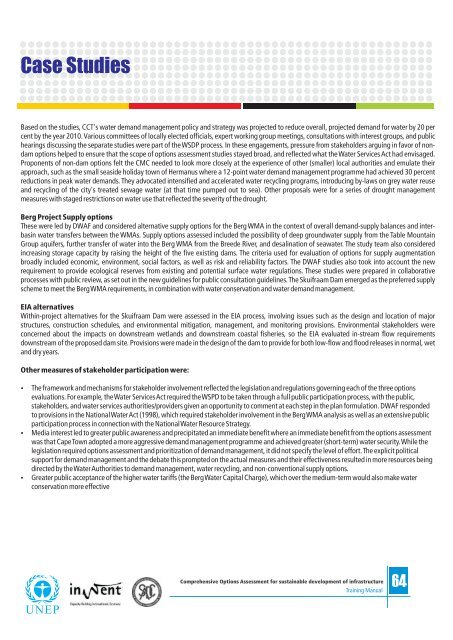Comprehensive Option Assesment - UNEP
Comprehensive Option Assesment - UNEP
Comprehensive Option Assesment - UNEP
You also want an ePaper? Increase the reach of your titles
YUMPU automatically turns print PDFs into web optimized ePapers that Google loves.
Case Studies<br />
Based on the studies, CCT's water demand management policy and strategy was projected to reduce overall, projected demand for water by 20 per<br />
cent by the year 2010. Various committees of locally elected officials, expert working group meetings, consultations with interest groups, and public<br />
hearings discussing the separate studies were part of the WSDP process. In these engagements, pressure from stakeholders arguing in favor of nondam<br />
options helped to ensure that the scope of options assessment studies stayed broad, and reflected what the Water Services Act had envisaged.<br />
Proponents of non-dam options felt the CMC needed to look more closely at the experience of other (smaller) local authorities and emulate their<br />
approach, such as the small seaside holiday town of Hermanus where a 12-point water demand management programme had achieved 30 percent<br />
reductions in peak water demands. They advocated intensified and accelerated water recycling programs, introducing by-laws on grey water reuse<br />
and recycling of the city's treated sewage water (at that time pumped out to sea). Other proposals were for a series of drought management<br />
measures with staged restrictions on water use that reflected the severity of the drought.<br />
Berg Project Supply options<br />
These were led by DWAF and considered alternative supply options for the Berg WMA in the context of overall demand-supply balances and interbasin<br />
water transfers between the WMAs. Supply options assessed included the possibility of deep groundwater supply from the Table Mountain<br />
Group aquifers, further transfer of water into the Berg WMA from the Breede River, and desalination of seawater. The study team also considered<br />
increasing storage capacity by raising the height of the five existing dams. The criteria used for evaluation of options for supply augmentation<br />
broadly included economic, environment, social factors, as well as risk and reliability factors. The DWAF studies also took into account the new<br />
requirement to provide ecological reserves from existing and potential surface water regulations. These studies were prepared in collaborative<br />
processes with public review, as set out in the new guidelines for public consultation guidelines. The Skuifraam Dam emerged as the preferred supply<br />
scheme to meet the Berg WMA requirements, in combination with water conservation and water demand management.<br />
EIA alternatives<br />
Within-project alternatives for the Skuifraam Dam were assessed in the EIA process, involving issues such as the design and location of major<br />
structures, construction schedules, and environmental mitigation, management, and monitoring provisions. Environmental stakeholders were<br />
concerned about the impacts on downstream wetlands and downstream coastal fisheries, so the EIA evaluated in-stream flow requirements<br />
downstream of the proposed dam site. Provisions were made in the design of the dam to provide for both low-flow and flood releases in normal, wet<br />
and dry years.<br />
Other measures of stakeholder participation were:<br />
The framework and mechanisms for stakeholder involvement reflected the legislation and regulations governing each of the three options<br />
evaluations. For example, the Water Services Act required the WSPD to be taken through a full public participation process, with the public,<br />
stakeholders, and water services authorities/providers given an opportunity to comment at each step in the plan formulation. DWAF responded<br />
to provisions in the National Water Act (1998), which required stakeholder involvement in the Berg WMA analysis as well as an extensive public<br />
participation process in connection with the National Water Resource Strategy.<br />
Media interest led to greater public awareness and precipitated an immediate benefit where an immediate benefit from the options assessment<br />
was that Cape Town adopted a more aggressive demand management programme and achieved greater (short-term) water security. While the<br />
legislation required options assessment and prioritization of demand management, it did not specify the level of effort. The explicit political<br />
support for demand management and the debate this prompted on the actual measures and their effectiveness resulted in more resources being<br />
directed by the Water Authorities to demand management, water recycling, and non-conventional supply options.<br />
Greater public acceptance of the higher water tariffs (the Berg Water Capital Charge), which over the medium-term would also make water<br />
conservation more effective<br />
<strong>Comprehensive</strong> <strong>Option</strong>s Assessment for sustainable development of infrastructure<br />
Training Manual<br />
64
















